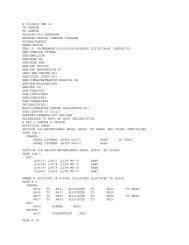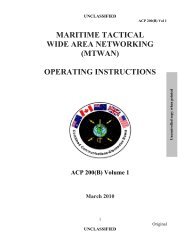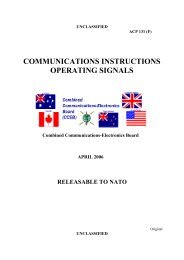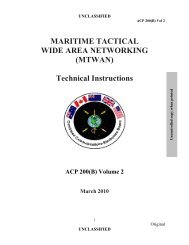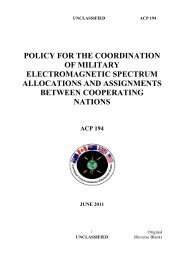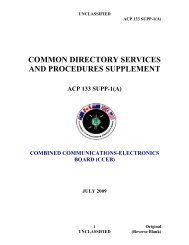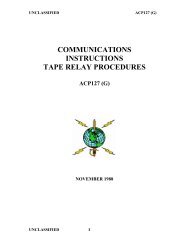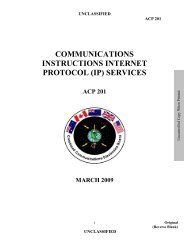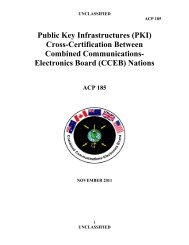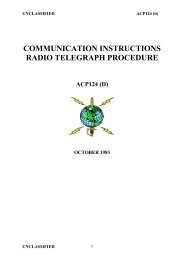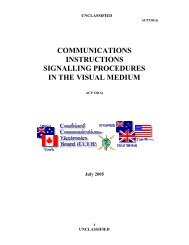ground routing protocol for use with automatic link establishment
ground routing protocol for use with automatic link establishment
ground routing protocol for use with automatic link establishment
You also want an ePaper? Increase the reach of your titles
YUMPU automatically turns print PDFs into web optimized ePapers that Google loves.
UNCLASSIFIED<br />
ACP193<br />
103. Back<strong>ground</strong><br />
(a) Military HF communication systems are being progressively upgraded, and the<br />
introduction of new technologies, are delivering much improved capabilities. In relation to<br />
the automation of channel selection and <strong>link</strong> set up procedures, systems are being procured<br />
which incorporate MS-ALE. This provides interoperable HF radio <strong>link</strong> <strong>establishment</strong><br />
<strong>protocol</strong>s and wave<strong>for</strong>ms to allow radios, which are configured to a common set of operating<br />
parameters to <strong>automatic</strong>ally negotiate a channel <strong>for</strong> communications when required by an<br />
operator.<br />
(b) When a communications circuit is established from a mobile to a HF <strong>ground</strong> station<br />
there may be the need to extend the <strong>link</strong> via a <strong>ground</strong> network (e.g. PSTN landline or similar<br />
telecommunications infrastructure) to another connected location. This can be achieved <strong>for</strong><br />
voice calls via a manual ‘phone patch’ which is set up by an operator at the receiving HF<br />
<strong>ground</strong> station and routed to a telephone handset at the connected location. Either the mobile<br />
radio operator or the telephone <strong>use</strong>r can request this type of circuit. Alongside the automation<br />
of the process to establish the radio <strong>link</strong>, it is desirable to also automate and enhance this<br />
process of setting up a phone patch.<br />
(c) This publication defines an interoperable HF <strong>ground</strong> <strong>routing</strong> <strong>protocol</strong> (the HF-GRP)<br />
which is to be <strong>use</strong>d over HF radio <strong>link</strong>s to specify the intended destination of a <strong>link</strong>, which is<br />
to be routed from a HF <strong>ground</strong> radio station via land-line. The <strong>protocol</strong> takes the <strong>for</strong>m of a<br />
<strong>for</strong>matted text message, which can be conveyed using MS-ALE.<br />
104. Functionality<br />
(a)<br />
The HF-GRP defined in this publication provides the following overall functionality:<br />
(1) Provision of an over-the-air <strong>protocol</strong> (message <strong>for</strong>mat) to enable end-to-end<br />
automated connectivity from a MS-ALE equipped mobile HF radio <strong>use</strong>r to a <strong>use</strong>r<br />
connected to a <strong>ground</strong> network, via a compatible HF <strong>ground</strong> radio station.<br />
(b) The detailed functionality is as follows :<br />
(1) Incorporation of message identifiers to distinguish a HF-GRP message from<br />
other text messages.<br />
(2) Incorporation of a call dial code, which specifies the required <strong>routing</strong><br />
destination <strong>for</strong> a call.<br />
(3) Provision of a call precedence capability.<br />
(4) Allowance <strong>for</strong> a hand-off traffic service, which may be clear voice, or a data<br />
based service.<br />
(5) Provision of mitigation against connection errors and unauthorised access.<br />
(6) Compatibility <strong>with</strong> mobile HF radios which are compliant <strong>with</strong> MS-ALE.<br />
1-2<br />
UNCLASSIFIED



